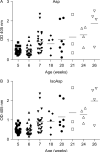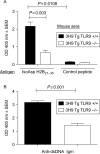Autoimmunity to isomerized histone H2B in systemic lupus erythematosus
- PMID: 22967069
- PMCID: PMC3543506
- DOI: 10.3109/08916934.2012.710859
Autoimmunity to isomerized histone H2B in systemic lupus erythematosus
Abstract
Histone H2B is a common target of autoantibodies in both spontaneous and drug-induced systemic lupus erythematosus (SLE). Recent studies demonstrate that Asp(25) of histone H2B (H2B) spontaneously converts to an isoaspartic acid (isoAsp) in vivo. Our laboratory has demonstrated that the posttranslational modification of an aspartic acid to an isoaspartic acid within self-peptides renders otherwise ignored peptides immunogenic. Analysis of serum from lupus-prone mice and histone antibody positive SLE patients revealed antibodies specific to the Asp and isoAsp H2B(21-35) peptide, and that the expression of these antibodies is dependent on TLR9. IsoAsp H2B(21-35) is immunogenic in non-autoimmune prone mice and mice lacking the ability to repair isoAsp have significantly reduced levels of antibodies to H2B. Asp H2B(21-35) incubated at physiological temperatures and pH acquires the isoAsp modification, demonstrating that H2B(21-35) is prone to spontaneous isoAsp formation in vivo. Autoimmunity to isoAsp H2B suggests that this form of the autoantigen may be critical in the induction of anti-histone autoantibodies in human SLE and in murine models of disease.
Figures







Similar articles
-
Apoptosis-associated acetylation on histone H2B is an epitope for lupus autoantibodies.Mol Immunol. 2009 Dec;47(2-3):511-6. doi: 10.1016/j.molimm.2009.08.009. Epub 2009 Sep 10. Mol Immunol. 2009. PMID: 19747733
-
Apoptosis-induced histone H3 methylation is targeted by autoantibodies in systemic lupus erythematosus.Ann Rheum Dis. 2011 Jan;70(1):201-7. doi: 10.1136/ard.2010.129320. Epub 2010 Aug 10. Ann Rheum Dis. 2011. PMID: 20699234
-
Nitration of H2B histone elicits an immune response in experimental animals.Autoimmunity. 2017 Jun;50(4):232-240. doi: 10.1080/08916934.2017.1347643. Epub 2017 Jul 24. Autoimmunity. 2017. PMID: 28737980
-
The central and multiple roles of B cells in lupus pathogenesis.Immunol Rev. 1999 Jun;169:107-21. doi: 10.1111/j.1600-065x.1999.tb01310.x. Immunol Rev. 1999. PMID: 10450512 Review.
-
Harnessing Tolerogenic Histone Peptide Epitopes From Nucleosomes for Selective Down-Regulation of Pathogenic Autoimmune Response in Lupus (Past, Present, and Future).Front Immunol. 2021 Apr 14;12:629807. doi: 10.3389/fimmu.2021.629807. eCollection 2021. Front Immunol. 2021. PMID: 33936042 Free PMC article. Review.
Cited by
-
Histones: The critical players in innate immunity.Front Immunol. 2022 Nov 21;13:1030610. doi: 10.3389/fimmu.2022.1030610. eCollection 2022. Front Immunol. 2022. PMID: 36479112 Free PMC article. Review.
-
Using mass spectrometry to identify neoantigens in autoimmune diseases: The type 1 diabetes example.Semin Immunol. 2023 Mar;66:101730. doi: 10.1016/j.smim.2023.101730. Epub 2023 Feb 22. Semin Immunol. 2023. PMID: 36827760 Free PMC article. Review.
-
Old Proteins in Man: A Field in its Infancy.Trends Biochem Sci. 2016 Aug;41(8):654-664. doi: 10.1016/j.tibs.2016.06.004. Epub 2016 Jul 11. Trends Biochem Sci. 2016. PMID: 27426990 Free PMC article. Review.
-
Multiple intra-articular injections with adipose-derived stem cells for knee osteoarthritis cause severe arthritis with anti-histone H2B antibody production.Regen Ther. 2023 Jun 26;24:147-153. doi: 10.1016/j.reth.2023.06.007. eCollection 2023 Dec. Regen Ther. 2023. PMID: 37415681 Free PMC article.
-
Biomarkers of autoimmunity and beta cell metabolism in type 1 diabetes.Front Immunol. 2022 Oct 27;13:1028130. doi: 10.3389/fimmu.2022.1028130. eCollection 2022. Front Immunol. 2022. PMID: 36389721 Free PMC article. Review.
References
-
- Mamula MJ, Gee RJ, Elliot JI, et al. Isoaspartyl post-translational modification triggers autoimmune responses to self-proteins. J. Biol. Chem. 1999;274:22321–22327. - PubMed
-
- Clarke S. Protein carboxyl methyltransferases: Two distinct classes of enzymes. Annu. Rev. Biochem. 1985;54:479–506. - PubMed
-
- Young AL, Carter WG, Doyle HA, Mamula MJ, Aswad DW. Structural integrity of histone H2B in vivo requires the activity of protein L-isoaspartate O-methyltransferase, a putative protein repair enzyme. J. Biol. Chem. 2001;276:37161–37165. - PubMed
-
- Young GW, Hoofring SA, Mamula MJ, et al. Protein L-isoaspartyl methyltransferase catalyzes in vivo racemization of Aspartate-25 in mammalian histone H2B. J. Biol. Chem. 2005;280:26094–26098. - PubMed
-
- Aswad DW, Paranandi MV, Schurter BT. Isoaspartate in peptides and proteins: formation, significance, and analysis. J. Pharm. Biomed. Anal. 2000;21:1129–1136. - PubMed
Publication types
MeSH terms
Substances
Grants and funding
LinkOut - more resources
Full Text Sources
Other Literature Sources
Medical
Molecular Biology Databases
